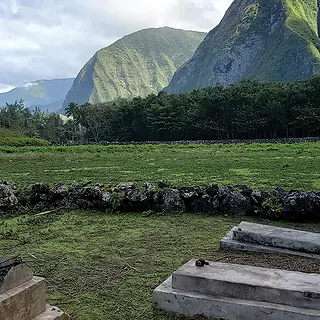
HOPE Crew Project Honors Hawaiians Quarantined on Kalaupapa
Late last winter, just before the world was realizing the global scale of the coronavirus pandemic, a group of 14 University of Hawai'i at Hilo students completed a gravestone cleaning project with the National Trust’s Hands-On Preservaton Experience (HOPE) Crew program. In a fluke of circumstance, the goal of the project was to honor the thousands of people who were once quarantined on the remote and rugged Kalaupapa peninsula on the island of Molokai. Now a National Historical Park, the peninsula is best known as the place where approximately 8,000 residents of Hawaii diagnosed with Hansen’s disease (leprosy) were forced into isolation over more than a century. Some endured incredibly difficult living conditions, and most spent the rest of their lives there.

HOPE Crew members cleaning grave markers at Papaloa Cemetery on Molakai's Kalaupapa Peninsula.
Selected as the location of a leprosy settlement by King Kamehameha V in 1865, the Kalaupapa Peninsula, on Molokai’s north shore, is cut off from what locals call the “topside” of the island by 2,000-foot cliffs. It remains one of Hawaii’s most isolated places. The population of permanent residents is limited to Park Service staff, state healthcare workers, and the few remaining patients who are now cured but chose to stay after living most of their lives in quarantine. “When the isolation law ended in 1969, residents were given the choice to leave,” says Kerri A. Inglis, professor of Hawaiian & Pacific History at the University of Hawai'i at Hilo. “But it was not easy for people to just return to their families. And when the park was established in 1980, patients who wanted to were allowed to remain.”
For the past 12 years Inglis has been taking groups of students to Kalaupapa for weeklong service trips. When the Park Service reached out to gauge her interest in having her students work with HOPE Crew there on cleaning the gravestones of Hansen’s disease patients, she jumped at the opportunity. “HOPE Crew’s objectives aligned with my desire to expose students to different career paths,” she says.
In addition to offering students hands-on training, the project immersed them in a little-known but important part of Hawaiian history. “The history of the peninsula started with ancient Hawaiians who had a settlement there,” says Inglis. “So you have the Native Hawaiian history layered with the arrival of Euro-Americans, the history of the people who were isolated there, and now the ongoing community layered with the national park. The main theme through all those layers is community, resilience, resourcefulness.”
For the students, all of whom have Native Hawaiian ancestry, the opportunity provided a way to honor that history and connect to their ancestors, but it also was something more. As student participant Nanea Thomas put it, “Cleaning the graves was hard work in a harsh environment, but it was very rewarding. I experienced happiness in its most elevated form … the opportunity to be with the great people giving their all to this special place, to take care of the place and the ancestors. There is no other place like it in the world.”

One of 1,200 known grave markers on Molokai’s Kalaupapa Peninsula.
Thomas describes Kalaupapa as “a contradictory place, of sadness and hard conditions, but of such beauty, as well. It was once a prison, but now it is a place of refuge, a piece of paradise, a place like what I imagine older Hawaiian lifestyles were like.”
The National Trust’s Molly Baker, who manages the HOPE Crew program, also noted Kalaupapa’s incongruous nature. “It is a rough place, but people made a home of it. The residents who chose to remain are so full of joy and hope.”
Starting at around 7 a.m. each day, the HOPE Crew team got together for piko, a UH Hilo College of Hawaiian Language tradition of carefully selected songs and chants that set the tone for the day. Then they ate a group breakfast before loading up whatever supplies were needed for the work ahead. Preservation experts James “Rusty” Brenner and Jason Church, along with Baker, provided training and supervision. Brenner, of Texas Cemetery Restoration, and Church, of the National Park Service, worked side by side with Inglis and her students as they learned to clean the gravestones using the gentlest means possible.
The first step was to remove any overgrown brush and vegetation. Then the group saturated the gravestones with water before applying D/2, a biological and biodegradable cleaner. After 10 to 15 minutes, workers scrubbed away debris with a soft brush and used detail tools to bring out lettering and carving before a final rinse with water.

More HOPE Crew participants clean a tomb outside the historic Siloama church.
At the end of the two-week project, the HOPE Crew participants accomplished more than they had set out to, cleaning not only every one of the 1,200 marked graves, but also five monuments, as well as clearing one cemetery of invasive growth. The work, says Inglis, will help to ensure that history is not forgotten. “90 percent of people sent to Kalaupapa were Native Hawaiian,” she says. “So almost every Native Hawaiian, today, has ancestors there. Cleaning the gravestones is honoring those people and their connection to all Hawaiians today.”
The completed project is also an acknowledgement of sacrifice. Upon returning from the isolated peninsula just as the coronavirus was emerging as a global pandemic, Inglis reflected on the people who were quarantined there. “We know from letters that many of the patients who were taken from their families understood what they were doing by going there,” she says. “They recognized that their sacrifice was for the protection of others. We can learn from that history and should never forget it.”
Donate Today to Help Save the Places Where Our History Happened.
Donate to the National Trust for Historic Preservation today and you'll help preserve places that tell our stories, reflect our culture, and shape our shared American experience.




